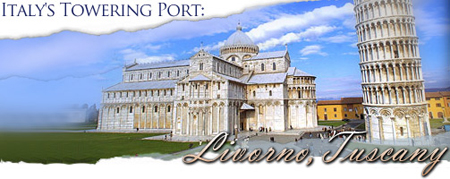|

Livorno, Tuscany - A Holland America
Port
The
traditional, yet refreshing, Tuscan
port of Livorno offers travelers on
the Holland America Line Mediterranean
Cruise an opportunity to experience
the whimsical lushness of the Tuscan
countryside. The Tuscany port is a great
place to stop and see some of the country's
most famous landmarks, including the
Leaning Tower of Pisa.
What
to See
Livorno's main feature - the bustling
Porto Mediceo - is where traditional
fishing vessels share space with today's
modern cargo ships from around the world.
Rebuilt after World War II, the broad
Piazza Municipio leads from the port
gate into the heart of the city. Piazza
Grande, graced by the central Duomo,
is the main focus of local life. Its
seaward end links to Piazza Micheli,
where Livorno's most prized sculpture,
the Monnumento ai Quattro Mori, rests.
The 1623 monument by Pietro Tacca features
images of four Moors, representing the
maritime conquest of North America.
If you venture into the Tuscan countryside
you'll feel as if you were transported
into the Middle Ages. Lucca's Renaissance
walls greet visitors with pretty, landscaped
gardens. Like Florence, Livorno is filled
with public art. The Duomo di San Martino,
though never quite finished, serves
as the foundation Pisan. A model for
all other Lucca churches, its sculptures
and paintings include Tintoretto's "Last
Supper," works by Fra Bartolomeo,
Filippino Lippi and Ilaria del Caretto.
Also left unfinished, the façade
of San Michele in Foro, was nearly completed
before funding for construction dried
up. Blending candy stripes and whimsical
twisted columns, the design was later
copied throughout the city.
San Gimignano, the former seat of power
for the Salvucci and Ardinghelli families,
is the most unusual of the Medieval
Tuscan towns. Of its 79 original towers,
13 remain intact to this day. The structures
provide visitors with a uniquely photogenic
silhouette. The highest tower, Torre
Grossa at Palazzo del Popolo, is open
for visitors to tour. Frescoes decorate
the walls of its two visual churches,
while Pinacoteca offers outstanding
paintings on display. The 10th-Century
Collegiata is one of the most decorated
churches in Italy. Though the exterior
is rather plain, the 14th-Century frescoes
illustrate exciting Biblical tales.
Rich in art and set in the hillside,
Siena is one of Italy's best-preserved
medieval towns. Many visitors are drawn
by the legend of St. Catherine (1347-1380),
who helped bring the Popes back from
exile. The Sienese are proud of their
immense unfinished Cathedral, with its
intarsia pavement and stunning striped
black and white marble exterior. Palazzo
Pubblico, flanked by the Mangia Tower
on Piazza del Campo, offers a splendid
view for travelers as well. Siena led
Emperor Frederick II's dynamic artistic
movement, which resulted in Tuscany's
13th-Century revival.
The Gothic devise of narrative where
people appear simultaneously in different
parts of a picture, relating a sequential
story, reached refined perfection in
the Siena School of Painting. The style
is brilliantly represented in the Siena
Art Gallery. Jacopa della Quercia, the
city's most famous architect and sculptor,
is responsible for the superb Baptistry
of San Giovanni font. Also, a visitor's
favorite is the Church of San Domenico,
known for its lovely frescoes and paintings.
Just 15 miles northeast of Livorno,
is the Roman navel base of Pisa. Later,
in the darkest days of the Middle Ages,
the base helped keep the coast free
of Saracens. A fleet of Pisan ships
was said to have sailed off during the
First Crusade, and by the 11th Century,
the city had developed into a maritime
republic that rivaled both Genoa and
Venice. At its height, Pisa captured
a large portion of Mediterranean territory,
including the islands of Sardinia and
Corsica.
Galileo Galilei taught at the city's
university, while other notables including
Percy and Mary Shelley resided in Pisa.
Currently, engineers are racing to save
the large tourist attraction, the Leaning
Tower. Lead weights at the base of the
tower balance its heavy mass. The project
continues, despite there being little
danger of its collaspe. In theory, the
Leaning Tower could be set level, but
many consider the possibility of changing
the city's top attraction unthinkable!
The surrounding Camo dei Miracoli (field
of miracles) was named after the marble
tower began to lean. The Duomo and its
Baptistry, both opposite the "main
attraction," also remain a bit
off-center.
History
The Etruscans, spread across the regions
of present-day Tuscany and Umbria as
long ago as 750 B.C., and were the first
to dominate the Italian land. Neolithic
remains have been found throughout the
area, though the Etruscans represent
the first known communities. Tuscany
is a derivation of the original tribal
name.
Livorno ("Leghorn") serves
as the Tuscan gateway. Though the Romans
established the port, it was not fully
developed until Florence's Medici family
transformed it into a thriving commercial
harbor. World War II bombs did destroy
most of the ancient city, but it has
since been rebuilt into the second largest
Italian port - the gateway to Tuscany's
magnificent artistic and architectural
wealth. Just a few miles away in Pisa,
the elegant Leaning Tower tilts precariously
as it has for centuries. A little further
is Lucca, and the remarkable hill towns
of San Gemignano and Sienna. However,
the jewel in the Tuscan crown is Firenze
(Florence), one of the world's most
magnificent medieval cities. Other lesser
known, but exciting to travel, gems
also dot the countryside.
Read
more about the Holland
America 10-Day Mediterranean Cruise.
|